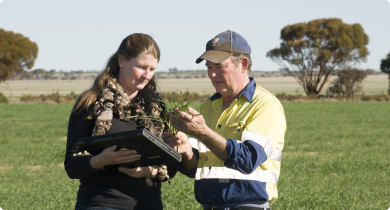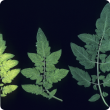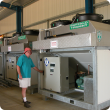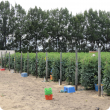Production & postharvest
The Department of Primary Industries and Regional Development contributes to the productivity, profitability and sustainability of plant-based agriculture. From broad scale dryland cropping systems to intensive irrigated production, we work with industry and business to address challenges in plant production through research and development, knowledge transfer and government policy settings.
Filter by search
Filter by topic
- Grains (190) Apply Grains filter
- Plant nutrition (98) Apply Plant nutrition filter
- Horticulture (85) Apply Horticulture filter
- Grains research & development (69) Apply Grains research & development filter
- Sowing (55) Apply Sowing filter
- Canola (53) Apply Canola filter
- Climate, land & water (50) Apply Climate, land & water filter
- Breeding & varieties (41) Apply Breeding & varieties filter
- Wheat (38) Apply Wheat filter
- Fertiliser (38) Apply Fertiliser filter
- Vegetables (36) Apply Vegetables filter
- Fruit (33) Apply Fruit filter
- Soil management (32) Apply Soil management filter
- Soils (32) Apply Soils filter
- Irrigation (22) Apply Irrigation filter
- Harvesting (22) Apply Harvesting filter
- Managing soils (21) Apply Managing soils filter
- Barley (21) Apply Barley filter
- Postharvest (20) Apply Postharvest filter
- Soil acidity (17) Apply Soil acidity filter
- Pulses (16) Apply Pulses filter
- Oats (15) Apply Oats filter
- Lupins (14) Apply Lupins filter
- Water (13) Apply Water filter
- Pests, weeds & diseases (13) Apply Pests, weeds & diseases filter
- Water management (12) Apply Water management filter
- Liming (12) Apply Liming filter
- Field peas (11) Apply Field peas filter
- Potatoes (10) Apply Potatoes filter
- Nursery & cutflowers (10) Apply Nursery & cutflowers filter
- Grapes & wine (9) Apply Grapes & wine filter
- Strawberries (8) Apply Strawberries filter
- Hay production (8) Apply Hay production filter
- Soil constraints (7) Apply Soil constraints filter
- Irrigated crops (6) Apply Irrigated crops filter
- Pastures (6) Apply Pastures filter
- Wine grapes (6) Apply Wine grapes filter
- Diseases (6) Apply Diseases filter
- Food, export & investment (6) Apply Food, export & investment filter
- Broccoli (6) Apply Broccoli filter
- Citrus (6) Apply Citrus filter
- Mangoes (5) Apply Mangoes filter
- Grains Research & Development (5) Apply Grains Research & Development filter
- Climate & weather (5) Apply Climate & weather filter
- Bananas (5) Apply Bananas filter
- Measuring and assessing soils (4) Apply Measuring and assessing soils filter
- Cauliflower (4) Apply Cauliflower filter
- Chickpeas (4) Apply Chickpeas filter







